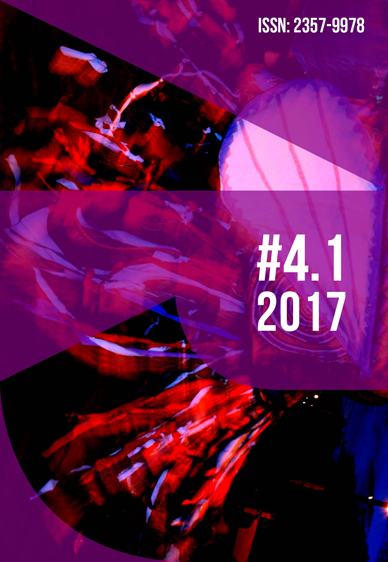Antigas estruturas para montagens teatrais contemporâneas
DOI:
https://doi.org/10.36025/arj.v4i1.10142Palavras-chave:
Antigas estruturas. Espaços teatrais. Teatros. Novos espaços adaptados. Montagens contemporâneas.Resumo
Este artigo busca investigar o papel da arquitetura no processo teatral e o uso de antigas estruturas para abrigar espetáculos contemporâneos de diretores brasileiros. Recentemente, o diretor José Celso Martinez Corrêa readaptou em diferentes lugares onde encenou Os Sertões, espaços similares ao seu Teatro Oficina em São Paulo. Outra possibilidade de novos arranjos para a arquitetura teatral é o teatro de arena, como por exemplo o Teatro SESC de Copacabana, no qual Miguel Vellinho dirigiu Peer Gynt com um cenário perfeito adaptado ao palco e criando uma interação ideal entre os atores e o público. Mas esses usos alternativos das arquiteturas existentes não são a única maneira de "encontrar o espaço", e demonstro como uma estrutura arquitetônica bem antiga pode propiciar espaços perfeitamente adequados para exibir drama nos tempos atuais como o Globe Theatre reconstruído não muito longe do local real do Shakespeare’s Globe, no qual Gabriel Villela encenou Romeu e Julieta em 2000.Downloads
Referências
BERKOWITZ, Gerald. Romeu and Julieta Shakespeare's GlobeSummer 2000. Available at: http://www.theatreguidelondon.co.uk/reviews/romeoarchive.htm. Accessed on March 10, 2013.
BRANDÃO, Carlos Antonio Leite. Grupo Galpão: uma história de risco e rito. 2a Ed. Belo Horizonte: o Grupo, 2002.
BROOK, Peter. O teatro e seu espaço. Petrópolis: Vozes, 1970 (1968).
CORREA, José Celso Martinez. Zé Celso’s interview in Domus. Available at http://www.domusweb.it/en/architecture/2012/05/21/the-street-is-a-theatre.html. Accessed on June 12, 2013.
COSTA FILHO, José da. Os sertões em cena:crítica, vocalização e cruzamento de sentidos. Sala Preta, v. 10, 2010, p. 77-92.
CUNIN, Muriel. Shakespeare et l´architecture. Nouvelles inventions pour bien bâtir et bien jouer. Paris: Honoré Champion Éditeur Br, 2008.
FITZPATRICK, Tim. “Reconstructing Shakespeare’s Second Globe using CAD design tools”, Early Modern Literature Studies, March 2004. Available at: http://www.shu.ac.uk/emls/emlshome.html. Accessed on October 10, 2012.
GREENBLATT, Stephen. Shakespearean Negotiations. The Circulation of Social Energy in Renaissance England. Berkeley, Los Angeles: University of California Press, 1988.
GROTOWSKI, Jerzy. Towards a Poor Theatre. New York and London: Routledge, 2002 (1968)
GURR, Andrew. The Shakespearean Stage:1574-1642. Cambridge University Press (fourth edition), 2009.
HILDY, Franklin. Colocando uma “cinta” ao redor do The Globe. Arqueologia e tamanho do teatro de Shakespeare. In: LIMA, Evelyn F.W. (org.) Arquitetura, Teatro e Cultura. Rio de Janeiro: Contracapa, 2012. P. 117-135.
LIMA Evelyn F. W. e LACROIX, Nicole, « Théâtre et Société dans la région du Minas au Brésil: Un public métis pour les salles de spectacle », Annales Canadiennes d’Histoire, n° 42, printemps/été 2007, p. 25-51.
LIMA, Evelyn F. W. «Aspectos da história de um espaço urbano de entretenimento: o sul de Londres nos séculos XVI e XVII”. in: FREITAS, Bernardino e MENDONÇA, Eneida.(org.) A construção da cidade e do urbanismo.ideias têm lugar? Vitória: EDUFES, 2012, p. 203-222.
MAGGIO, Sérgio. Article published in Correio Braziliense on October16, 2007.
PAVIS, Patrice, « L’enfantement de la scène », Le Théâtre au croisement des cultures, Paris, José Corti, 1990.
SCHECHNER, Richard. Environmental Theater. New York: Hawthorn Books, 1973.
SUGERS, Anne. Scénographies du théâtre occidental. Paris: Armand Colin. 2010.
VELLINHO, Miguel. Peer Gynt. Description of the production. Available at http://www.pequod.com.br, Accessed on Mai 20, 2006.
WATERS, Michael, “An audience does not only go to the theatre…..” Innervate, 2019-2010, pp. 417-426. Available at http://www.nottingham.ac.uk/english/documents/innervate/09-0/0910watersperfomancesites.pdf. Accessed on June 25, 2011.
WÖLFFLIN, Heinrich, Prolégomènes a une psychologie de l´architecture (1886) trad. Bruno Queysanne, Grenoble: La Villete Editeurs, 2005.
Downloads
Arquivos adicionais
Publicado
Como Citar
Edição
Seção
Licença
Copyright (c) 2017 Evelyn Furquim Werneck Lima (Autor)

Este trabalho está licenciado sob uma licença Creative Commons Attribution-NonCommercial-ShareAlike 4.0 International License.

Esta obra está licenciada com uma Licença Creative Commons Atribuição-NãoComercial-CompartilhaIgual 4.0 Internacional.
Autores detêm os direitos autorais ao licenciar sua produção sob Creative Commons Atribuição-NãoComercial-CompartilhaIgual 4.0 Internacional.


 English
English Português (Brasil)
Português (Brasil)
